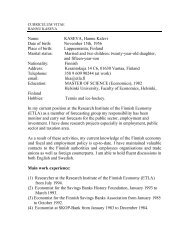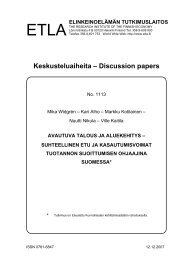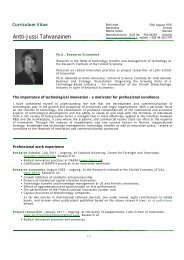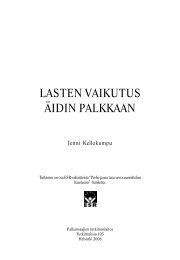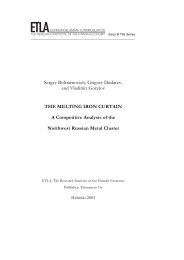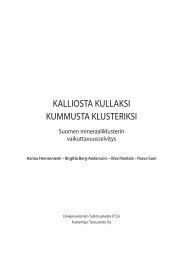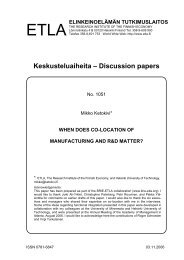Schooling, Family Background, and Adoption: Is it Nature or is ... - Etla
Schooling, Family Background, and Adoption: Is it Nature or is ... - Etla
Schooling, Family Background, and Adoption: Is it Nature or is ... - Etla
Create successful ePaper yourself
Turn your PDF publications into a flip-book with our unique Google optimized e-Paper software.
2.2 Intergenerational mobil<strong>it</strong>y of parental income<br />
Both parental human cap<strong>it</strong>al <strong>and</strong> abil<strong>it</strong>y affect the human cap<strong>it</strong>al investment<br />
of children through family income, which <strong>is</strong> clearly seen when we combine<br />
(2.2) <strong>and</strong> (2.3) <strong>and</strong> we wr<strong>it</strong>e down f<strong>or</strong> today’s generation<br />
h t = c 0 + b 0 c 2 + c 1 y t−1 + b 1 c 2 e t−1 + w t + c 2 v t (2.6)<br />
Because high abil<strong>it</strong>y parents generate on average m<strong>or</strong>e income, there <strong>is</strong><br />
collinear<strong>it</strong>y between e t−1 <strong>and</strong> y t−1 , which means that the imp<strong>or</strong>tance of<br />
parental income <strong>and</strong> abil<strong>it</strong>y per se cannot be obtained by means of direct<br />
estimation. An alternative way to identify these effects <strong>is</strong> to <strong>is</strong>olate that<br />
part of parental income that represents income out of “luck”, namely u t−1 .<br />
If luck <strong>is</strong> identified, we are able to use luck as an instrument in (2.6) <strong>and</strong><br />
shed light on the overall contribution of abil<strong>it</strong>y, e t−1 . Also, equation (2.5)<br />
allows us to estimate income effects directly through c 1 u t−1 . Later on, Section<br />
5 will explain the methodology of how we <strong>is</strong>olate income generated out<br />
of market luck. 6<br />
2.3 Intergenerational mobil<strong>it</strong>y of abil<strong>it</strong>y: nature <strong>or</strong> nurture?<br />
In th<strong>is</strong> paper we refer to cogn<strong>it</strong>ive abil<strong>it</strong>y whenever we d<strong>is</strong>cuss abil<strong>it</strong>y, <strong>and</strong> we<br />
use IQ test sc<strong>or</strong>es to measure <strong>it</strong>. 7 The model clearly shows that abil<strong>it</strong>y matters.<br />
How much <strong>it</strong> exactly matters <strong>is</strong> extensively debated in the l<strong>it</strong>erature.<br />
Some argue that IQ <strong>is</strong> only a po<strong>or</strong> predict<strong>or</strong> of school perf<strong>or</strong>mance (Cawley<br />
et al., 1996). Others claim that IQ <strong>is</strong> the driving f<strong>or</strong>ce in explaining human<br />
cap<strong>it</strong>al accumulation (Herrnstein <strong>and</strong> Murray, 1994). The imp<strong>or</strong>tance of<br />
abil<strong>it</strong>y transfers increases if IQ <strong>is</strong> thought to be hered<strong>it</strong>ary.<br />
Th<strong>is</strong> paper adds to th<strong>is</strong> debate. It inserts new evidence on the imp<strong>or</strong>tance<br />
of the her<strong>it</strong>abil<strong>it</strong>y of IQ, evidence that <strong>is</strong> based on a novel approach.<br />
F<strong>or</strong> parents <strong>and</strong> their biological children, abil<strong>it</strong>y transm<strong>is</strong>sions run through<br />
both genetic <strong>and</strong> cultural channels. F<strong>or</strong> adopted children, however, genetic<br />
transfers do not ex<strong>is</strong>t. Define the variable δ t to denote the biological status<br />
6 Studies on the effect of family income on children’s education mostly relied on realized<br />
income measures. There are only a few studies that have actually examined the relation<br />
between children’s outcomes <strong>and</strong> income using parental income measures that overcome<br />
the endogene<strong>it</strong>y of parental income w<strong>it</strong>h repsect to children’s abil<strong>it</strong>y (Mayer, 1997; Blau,<br />
1999; Plug, 1999; Shea, 2000).<br />
7 The measurement of cogn<strong>it</strong>ive abil<strong>it</strong>y <strong>or</strong> intelligence has a long h<strong>is</strong>t<strong>or</strong>y, <strong>and</strong> the prevailing<br />
idea <strong>is</strong> that IQ tests do a reasonable job in measuring <strong>it</strong>; see Spearman (1927) <strong>and</strong><br />
m<strong>or</strong>e recently Cawley et al., (1996).<br />
6




